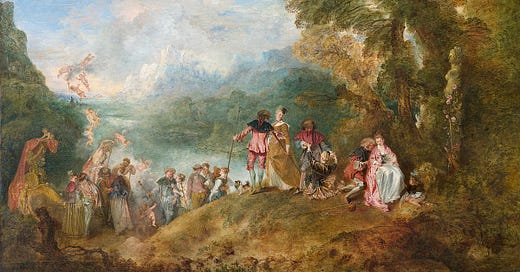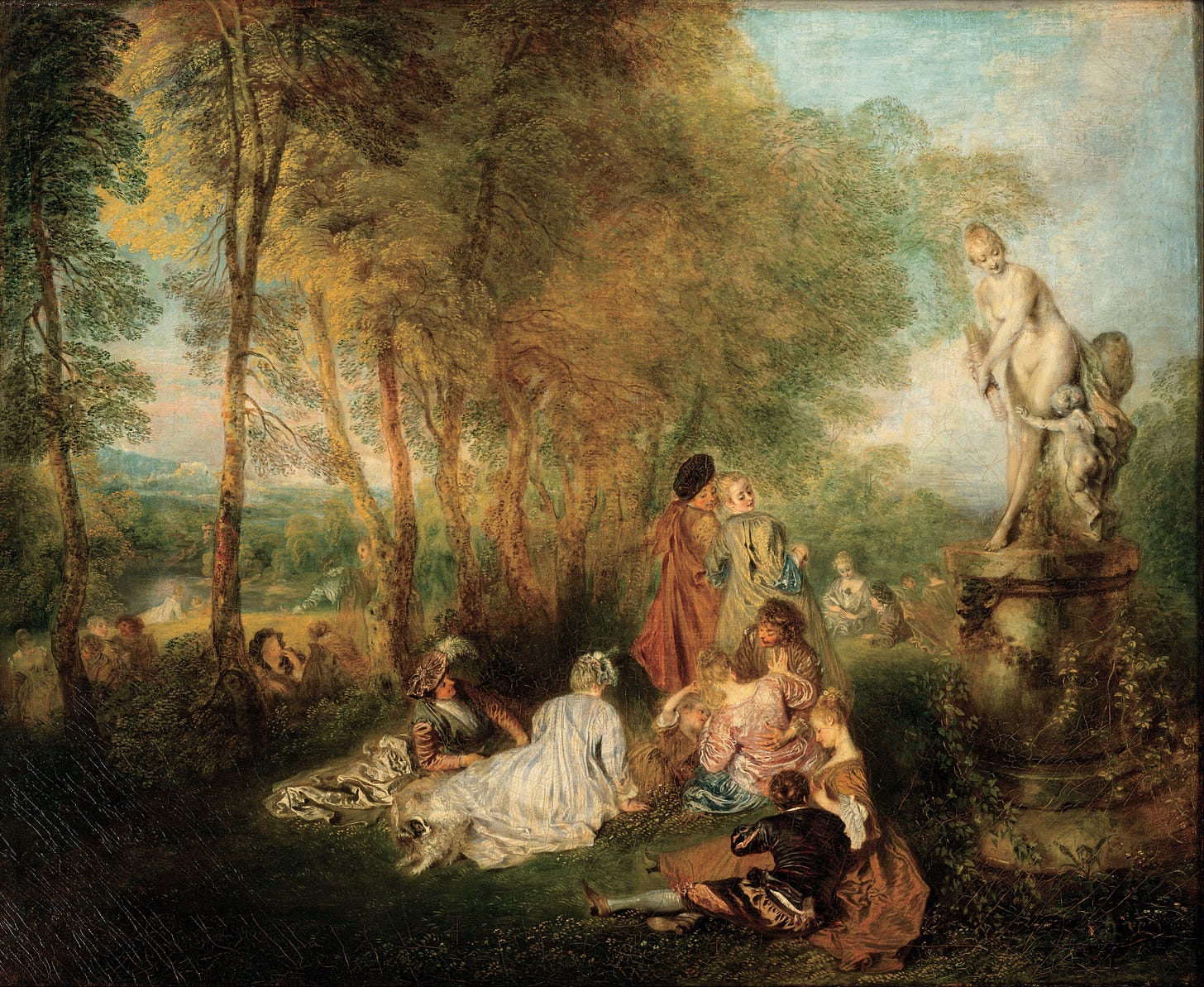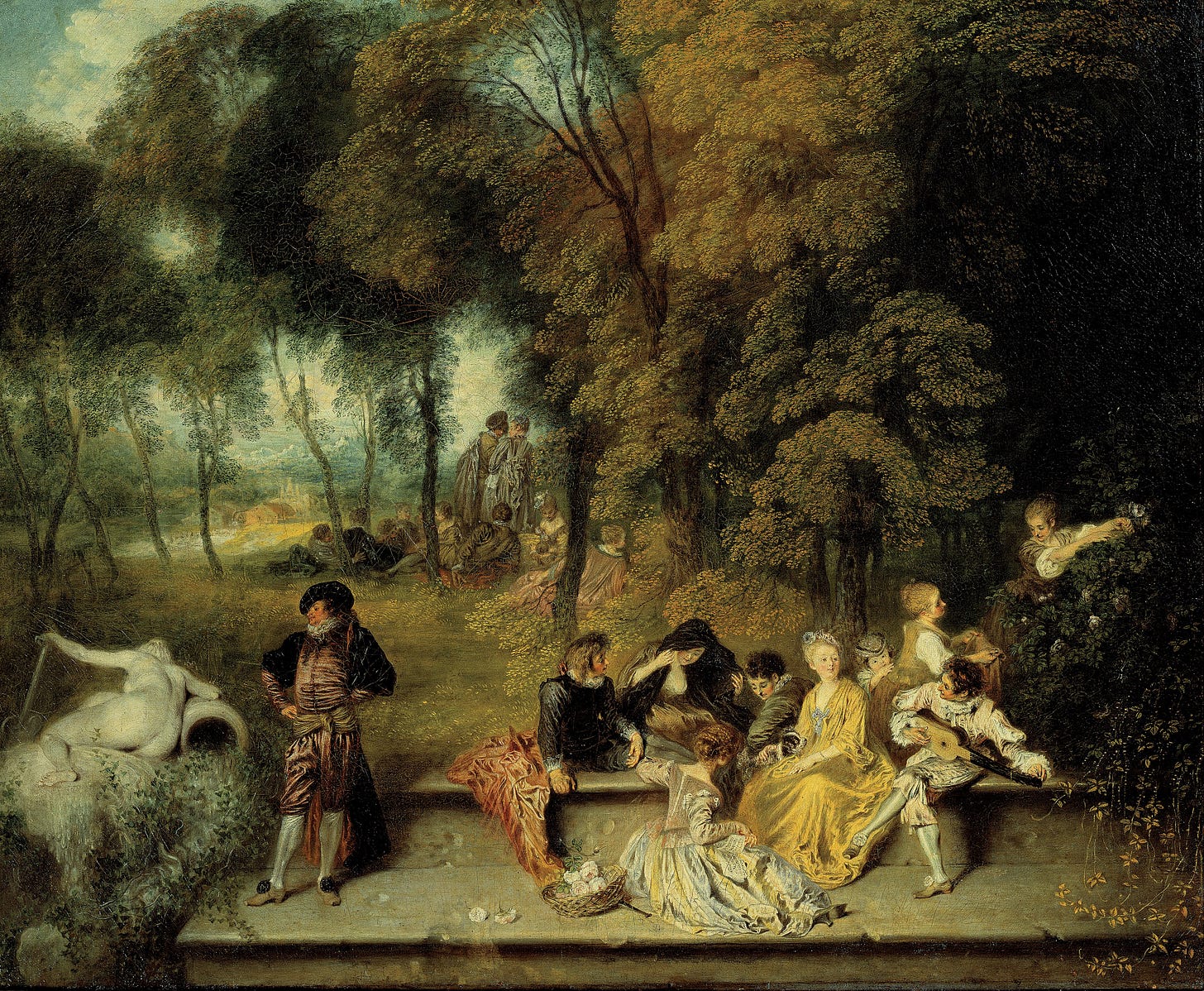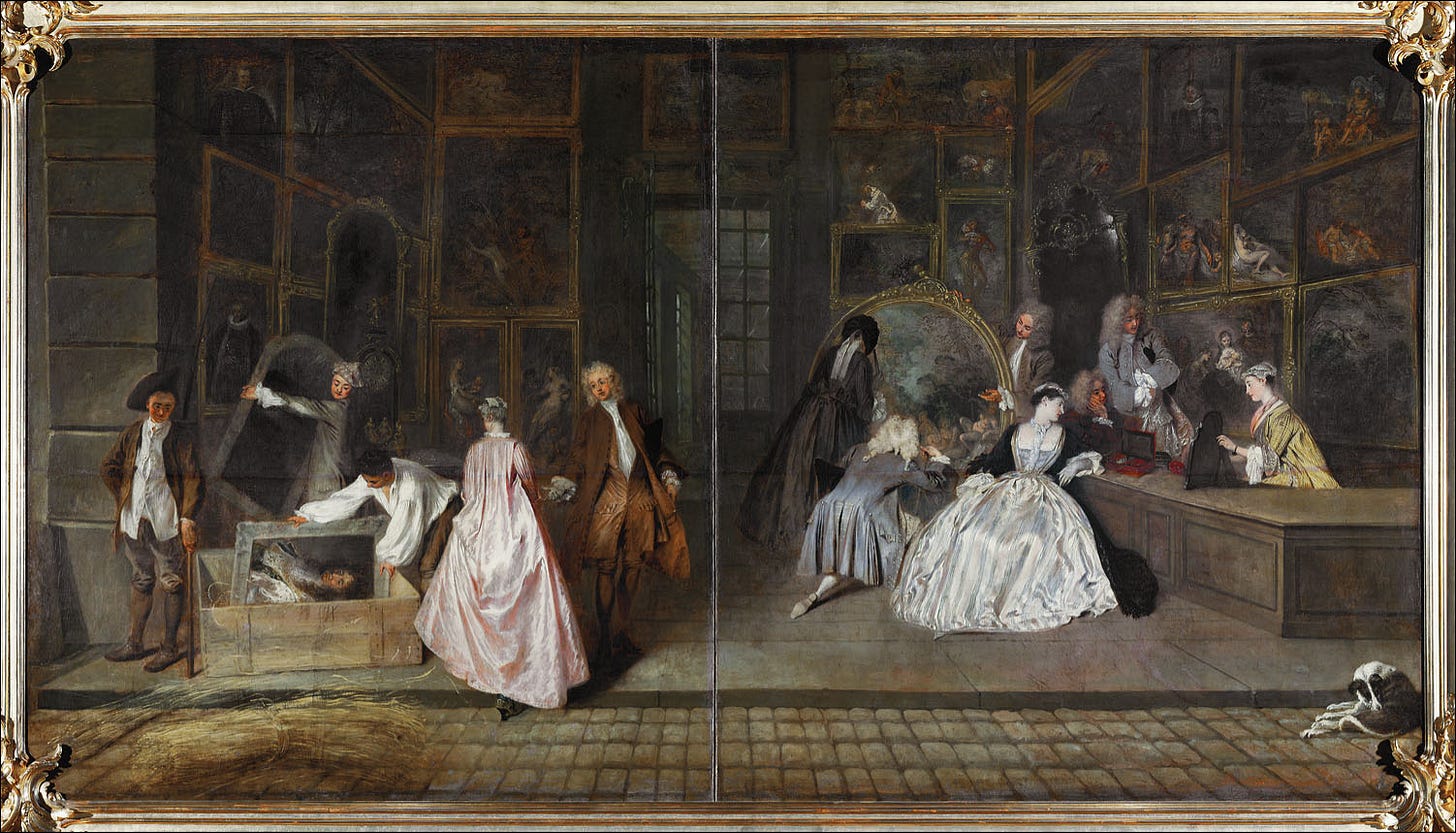It is now one of the most famous paintings of the 18th century—: Watteau's “Gilles”. Once, it is said, it carried an inscription: “How happy would Pierrot be if he was acquainted with the art of being liked by you”. The inscription was lost due to years of bad storage and neglect—the painting damaged; it comes to us by way of an old anecdote of the Monsieur Meunier—that needs not be retold here. During the Revolution, Watteau's works, the “Gilles” among them, were removed from the fine and royal galleries by men who saw in them the epitome of Ancien Regime taste: representations of noble wastefulness, aristocratic fancy—of a world they could not understand, only condemn. During the Premier Empire, i.e. the Age of Napoleon, when a new nobility arose—fishmongers made marshals, cobblers made counts—many works of Watteau sat in Parisian art shops. It is said that students of Jacques-Louis David, an artist now en vogue, vandalized some of Watteau's work. Finally, towards the end of Napoleon's reign, the “Gilles” was bought for a meagre 100 Francs by the famed Egytologist Vivant Denon. The painting would switch hands several times in the 19th century, always increasing its price—from 100 Francs to 500, to 650, to 800, finally to 16000—, the number of interested buyers steadily growing. Watteau came back into fashion. The Brothers Goncourt, the great tastemakers of late 19th century Paris then finally crowned him with the famous declaration: “The greatest [French] poet of the 18th century is Watteau”. A polemical voice may say: That does not surprise; the French 18th century was an age of prose; their poetry, widely seen as such, was meagre—but even if so, the Goncourts inculcated in many minds the belief in the greatness of the painter Watteau as the poet Watteau.
But what is there to “Gilles”; what is there to say about the painting? And that fabled lost inscription? The figure—Pierrot, the clown; also named Gilles—looks directly at the spectator, seems to invite questions—while all other figures, most likely a theatre troop, seem captivated by a donkey. Watteau painted the “Gilles” towards the end of his life, in 1719. We know that the painting was used, strange though it sounds, to advertise a play. A theatrical painting advertising a theatrical production. Indeed, in 1721, a new theatre in Paris, opened by the actor Belloni—the very man who, according to extant documents, commissioned the painting in 1718—staged a play in the Commedia dell'arte tradition in which a Pierrot, a clown, is turned into a donkey. But is the costumed man, who looks at us so directly, even an actor? Some wondered: Could it be Watteau himself, a hidden self-portrait? You argue that there is a likeness between the “Gilles” and the portrait we have of Watteau made by Rosalba Carriera. But there is no way to answer this question. Watteau's paintings have a reputation to be very hard to “decode”, to “interpret”; little is known about Watteau, little is known, in actual documents, about many of his paintings; and his subject matters further complicate it. The Goncourts called him the greatest poet, many contemporay scholars argue that his works contain nothing “speculative” or “transcendental”, that he worked entirely within preestablished and profane formal conventions. And yet—all of his compositions, do they not merely serve as a foundation for an overflow of poetic sentiment? A Watteauian poetics—quite like we see a poetics in the works of the Venetian master Giorgione. But to return to the “Gilles”—the painting was used, most likely, as a theatre advertisement. This brings us back to the inscription: “How happy would Pierrot be if he was acquainted with the art of being liked by you”. Does the inscription not indicate an homage to—the poor clown? The poor clown who stands before the spectator and says: Ecce Homo—whose somber face speaks to the dignity of the grotesqueness of the role. And his placement in the painting intensifies it almost to the point of exhibitionism: He does not stand on an actual stage but is presented in a dreamlike landscape—there is thus a distance between the “Gilles” and his “reality” (the physical stage). While Watteau creates a distance between his subject and his “habitat”, he compositionally closes a different distance—that between the subject of the “Gilles” and the spectator: “Gilles” is placed as if he stepped into the spectator's space, almost invasive, looking directly at them, singling them out. “Are you entertained?”, he almost seems to ask.

A dream-stage, a dreamlike landscape—this is perhaps legible to us: It must remind us of the genre of painting Watteau is most famous for, the fêtes galantes, the “courtship parties”, a genre of painting Watteau himself created and perfected, and that is often seen as the epitome of the Rococo genre painting, but: Watteau’s fêtes galantes are easily distinguished from the pastoralesque and much more representative scenes of the later of Rococo, such as Fragonard’s “Swing”: In Fragonard, the movement of the swing, the shoe flying off the lady’s foot, the enamoured voyeur ready to catch—all accelerate toward a single piquant “punchline”. But in Watteau’s parties, the swing does not move, the figures are all veiled—rather than dressed—in rich silk; they are, even in the social settings they are shown in, usually alone, compositionally isolated, standing still. Watteau’s figures never—as they do in Fragonard, in Boucher, in the masters of the later French Rococo—work collectively as a single overriding ornament. Or perhaps we could say: In Fragonard, de Troy, Lancret, or Boucher, all movement aimes to depict action, i.e. a “plot”; whereas in Watteau, all action is entirely reduced to the “mereness” of gesture, to sparing signs and stances, glances; nuances are hidden in the drapery of the veiled. The later 18th and particularly much of the 19th century saw in this a poverty of expression—Watteau, the cold painter, the static painter; but really it was: Watteau, the subtle painter, the refined classicist—in his figures, his social composition. If one seeks immediate and strong expression in Watteau, one needs to behold—and here we return—his poetically-charged landscapes: wild, unkept, untamed, a seemingly infinite sprawl, diffused by light. The “Gilles” painting shows us no horizon; that, too, that the Pierrot/Gilles prevents us from looking deeper into the landscape, thereby creating the illusion of excessive physical depth, is part of the painting’s genius. And indeed, we know that Watteau would always start a painting by quickly sketching out the landscape, and then assembling the figures “on top of it”—deriving the figures themselves from a large collection of “characters” he had assembled in a sketchbook—, rather than organically within. The “Gilles”, not a person but a character—Commedia dell’arte—stands “on top of” the landscape. And this is why, as indicated, the figures in the “Gilles”, though they all belong to the same moment, the same social ensemble, though they all correspond to one another—are also fundamentally distant from each other, their gazes never meet, and neither do they all behold the donkey with the same expression, or from the same angle. They all behold, but they behold alone; as the “Gilles” beholds us; while we, as spectators, behold them all.
Watteau’s true genius was to add figures into compositions in a way that enhances the background, the landscape, makes the landscape become—the stage. Therein we see the Baroque heritage of Claude Lorrain, of Poussin, also of Rubens: the “Stage of the Gods”, the mythologized landscape: genres of the refined classicist Baroque that preceded Watteau. And just as Lorrain or Poussin drew from a catalogue of established characters to furnish their painting—from “tropes”, to lift a term from classical rhetoric—so does Watteau. Here also it is wise to consult the history of fashion—to find that the clothing Watteau drapes his figures in would most likely have been seen as antiquated or slightly unfashionable in his own day—but that, of course, they also weren’t the mythologized clothes expected in the genre scenes of the classicist Baroque genre painting. Real clothing, but out of fashion; thus the choice of drapery appears a conscious modernization of the Baroque mythological genre, while, at the same time, it consciously employs an archaism relative to his own time—presumably to still maintain an Arcadian distance, a sentimental distance shored up against nascent rationalism and “realism”.
A formal invention, a strange combination—the origins of which are hard to parse. Watteau was born in 1684, the son of a roofer in Valenciennes, close to the Flemish border. He entered into an apprenticeship with a Flemish painter at an early age, but little is known about it. The Flemish origins of his paintings, traces of the Flemish tradition at least, have often been stated. At the age of 17, Watteau went to Paris, where he worked in a commercial workshop, fashioning small canvases for small people and little money. Soon after, in 1705, he was discovered by the painter Gillot, who took him on as a proper apprentice. Under Gillot he refined his Flemish-influenced style, and came into contact with the world of theatre, specifically with the popular comedies played on small stages or in the cafes for Paris’ nascent Bourgeoisie. The images inculcated in him very practically at that time—scenes from the Commedia dell’arte, from the comedies of Moliere, etc—would remain an influence on his painting for the rest of his life. In the next stage of his life, Watteau started to work under the decorative painter Claude Audran. Up until that point, Watteau had at no stage in his training as a painter come into contact with “the great tradition”, with the works and themes of the great painters, with the taste of the aristocracy—in a word: with the mythological scene. But Audran was one of the administrators of the galleries of the Palais du Luxembourg, and here Watteau had daily access to Rubens’ massive 24-painting Medici-Cycle, one of the greatest works of Baroque painting, nowadays exhibited in the Louvre. Inspired by this new experience, Watteau enrolled in the French academy’s 1709 competition for the Prix de Rome—hoping to win a stipend and study in the Villa Medici in Rome—, and he did so with a biblical scene. He did not win the prize—he would, in fact, never win the Grand prix—but taking part in the competition introduced him to the world of fine painting in Paris, a world he had hitherto been unknown to. He got private commissions—which is also the reason why, even today, when he is commonly accepted as the greatest French painter of the 18th century, and perhaps alongside Tiepolo the greatest of the age in general, so many of his works are hidden from the public and scholarly examination in old private collections. Anyway, from this point on, he would always find, here and there, men of distinction who had an appreciation for his unorthodox work. In 1712, he tried once again to win the Grand Prix of the academy—but did not. Instead, Charles de La Fosse, a senior member of the academy offered him—and that was much more valuable than a stipend to go to Rome—a membership in the academy. To become a member, one had to present the academy with a painting—a masterpiece; but Watteau, for reasons that we are not entirely privy to, took an unprecedented five years to present the academy with a painting for his admission. That painting is the now famous and cherished “Embarkation for Cythera” from 1717. At the same time, he immediately accepted the invitation to the house of the renowned patron and collector Pierre Crozat—from whose collection of Italian Renaissance works—a surviving catalogue mentions 19000 works—Watteau was said to have taken inspiration. More or less turning his back on the academy in favour of the employ with a private collector—has often made scholars call Watteau an “anti-academic”, and it is true—as we said—that the formal novelties of his paintings deviate quite distinctly from what was being taught at the French academy at the time. The mannerist influences via Rubens, the ability to mute colours like the Venetians, the frequent usage of theatrical characters and constellations, the archaic fashion, the deviation from the official idea of the mythological scene—they all make Watteau out as a man of his own devices, of a painter who stands in his time, but does not really pair with any contemporary. Is is not remarkable then that just a century later he would be seen as *the* painter of the early 18th century, perhaps even *the* painter of the Ancien regime?
Watteau, who was a man of life-long frail health, would remain a solitary figure until the day he died. From what we know he never had many friends, rarely took on students, did not care about his future or his finances, never married, never had children. He also, many anecdotes tell of it, was extremely self-critical as a painter; that seems to have been the only aspect of life he cared for, and he did so intensely. Watteau left the household of Crozat in 1720 and travelled to London, probably to meet the famous physician Mead, probably also to sell paintings to the English upper-class. Neither plan seems to have worked out. He returned to Paris in 1721—where he painted one of his most enigmatic works, the “Shop Sign of Gersaint”, and then died shortly after of tuberculosis at the age of 37.









Brilliant. First time hearing about the Gilles painting, but it’s really something special. It strikes me as a bit suspended in time, as if speaking to a sentiment that would only be felt in France much later.
I didn't know about this very intriguing painting. A great article, that I read during my work hours, as every aristocrat should. Thank you!